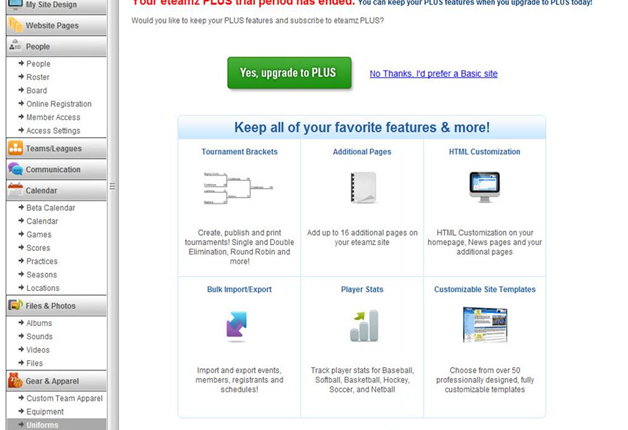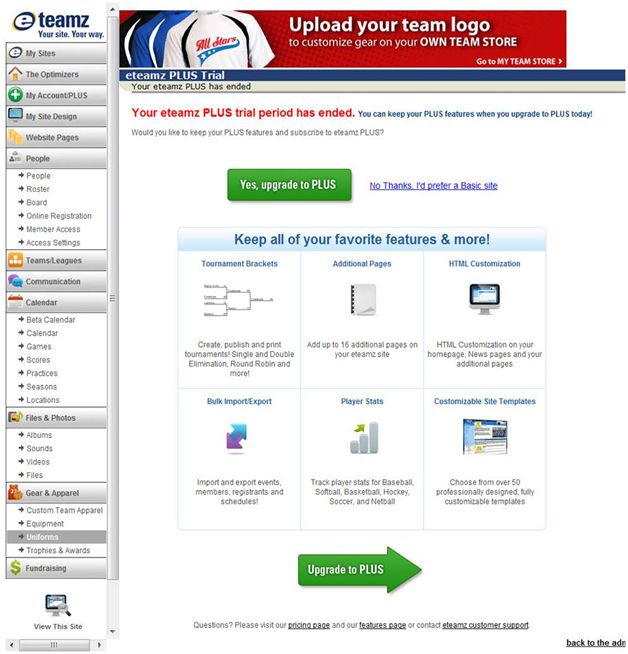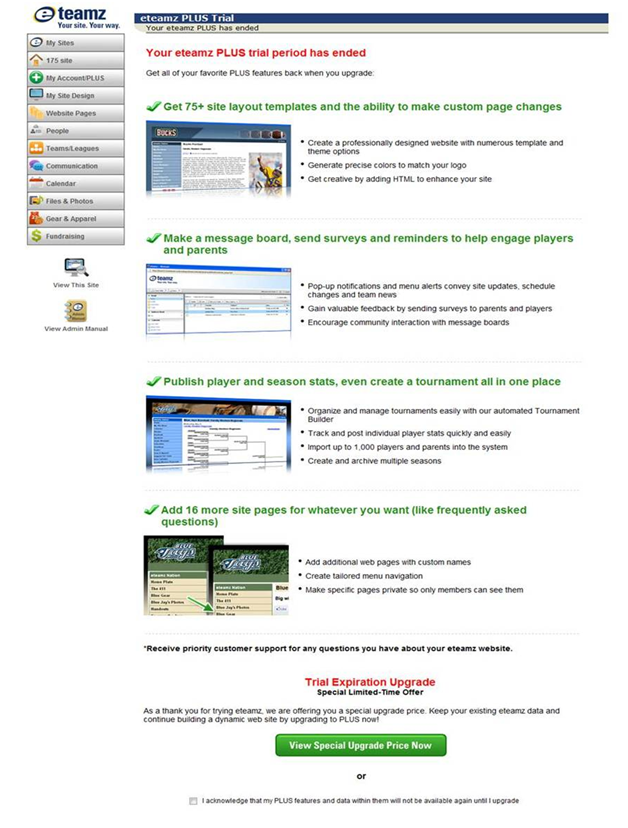One of my favorite trials of a premium service was in the golden era of cable television, when the Internet as a whole was still in its infancy and premium cable channels, like HBO, would occasionally open their doors and give basic service subscribers a taste of new movies, live boxing and George Carlin specials.
Although marketing has changed significantly since the cable era of the 80s, two things have not changed:
- Premium service trials have the potential to be powerful incentives that increase revenue.
- Marketers are challenged to discover ways to capture that potential increased revenue once a trial offer has ended.
Recently, one of MECLABS’ Research Partners, eteamz, a sports website management company that offers a free sports site builder, faced the challenge of increasing conversions after its premium service trial ends. Let me give you a little background on how the eteamz PLUS trial offer works …
First, users can sign up for a free sports site builder that offers basic features. As part of signing up, eteamz includes a trial of its PLUS service.
When the trial of PLUS ends, an interrupt page appears, asking users to decide whether to remain with the free basic service or to accept the offer to upgrade to eteamz’s premium service.
After an analysis of the eteamz site, the MECLABS research team decided that the interrupt page possessed the greatest potential for increasing conversion, so the experiment below was designed to discover which interrupt page would result in an increase in conversions after the trial of the PLUS service ended.
Here is a screenshot of the control interrupt page.
Control
In the control, once the premium service trial expired, an interrupt page with calls-to-action to either upgrade or to keep the basic service was presented before the value of upgrading the service was clearly demonstrated.
Treatment
In the treatment, the value of the upgrade was optimized by stacking and highlighting the features and benefits in bullet points with supporting images.
A single call-to-action that was moved to the bottom of the page. The CTA was also paired with a one-time use-or-lose incentive offer and warning that the data held within the premium features would not be available again until an upgrading service occurred.
Results

The treatment outperformed the control by a relative difference of almost 43% at a level of confidence of 95%.
What you need to understand
When I asked Jon Powell, Senior Research Manager, MECLABS, for a few takeaways for marketers testing interrupt pages based on the results of this test, he offered a couple of suggestions.
Takeaway #1: Express your value proposition
A strong value proposition that effectively appeals to your ideal customers requires marketers to think holistically about communication. To help you do this, there are three key principles:
Congruence: Have every element of your page either state or support the value proposition. (This can be expressed in your logos, price, design features, images, colors, etc.) One example of congruence found in the test above are the images that were included in the treatment to support the value proposition of the upgrade.
Continuity: Make certain that each step of the buy process either states or supports the value proposition.
“It seems customers have a hard time remembering value as they progress through the steps, much like I have a hard time remembering where I put my car keys after I get home. The principle of continuity will help your customers remember why they are there and why they should continue,” Jon said.
Credibility: Make certain that every statement of value is communicated in a way that is instantly credible. If you want a good example of an instantly credible statement from the experiment above, compare the difference between the control and treatment for the eteamz site template feature …
Control: “Create, publish and print tournaments. Single and double, round robins and more!”
Treatment: “Publish player and season stats, even create a tournament all in one place”
- Organize and manage tournaments easily with our automated tournament builder
- Track and post individual player stats quickly and easily
- Import up to 1,000 players and parents into the system
- Create and archive multiple seasons
The treatment headline replaced the general description “and more!” and used bullet points with specific facts that added instant credibility to the value of the feature.
Takeaway #2: Incentives
The MarketingExperiments Landing Page Optimization Online Certification Course teaches that incentives are “the introduction of an appealing element to stimulate a desired action.”
Many different types of incentives can be used (free shipping, extra product, discounts, etc.) to overtake the forces of friction that are pulling your ideal prospects out of your sales funnel. The challenge is to find the right incentive for your customers. All marketers should ask themselves two questions when considering incentives for their customer base:
- Is the incentive relevant? – Does your incentive appeal to the motivations of your ideal customer, and does it complement (or conflict) with the heart of what the page initially offers.
- Is the incentive practical? – Discovering highly relevant incentives with appeal to your customers is nice, but they are ultimately useless if not practical. The practicality of your incentives should be viewed in terms of cost vs. ROI and logistics of delivering the incentive to your customers.
Related Resources:
Email List Reactivation Incentives: Gift cards vs. whitepaper vs. nothing (A case study from MarketingSherpa, our sister company)
Incentive: The bacon of marketing tactics
Homepage Optimization: 5 questions every marketing team should ask themselves






I love your point about value proposition. In my experience of running a conversion rate optimization agency (2X Conversion), one of the most important parts of our internal methodology for Conversion Rate Optimization is value proposition.
We often find that clients either don’t have a clear understanding of their own value proposition (e.g: Are you the cheapest? Are you the highest quality in the market? Why should I use your service rather than your competitors) or struggle to communicate their value clearly and succintly.
If you think about this, this is really at the core of all marketing – not just conversions. If you don’t understand the clear value that you’re delivering to the customer and make that value clear and truthful, you’re in trouble from a marketing perspective.
And this will naturally have a big effect on your conversion rate.
James